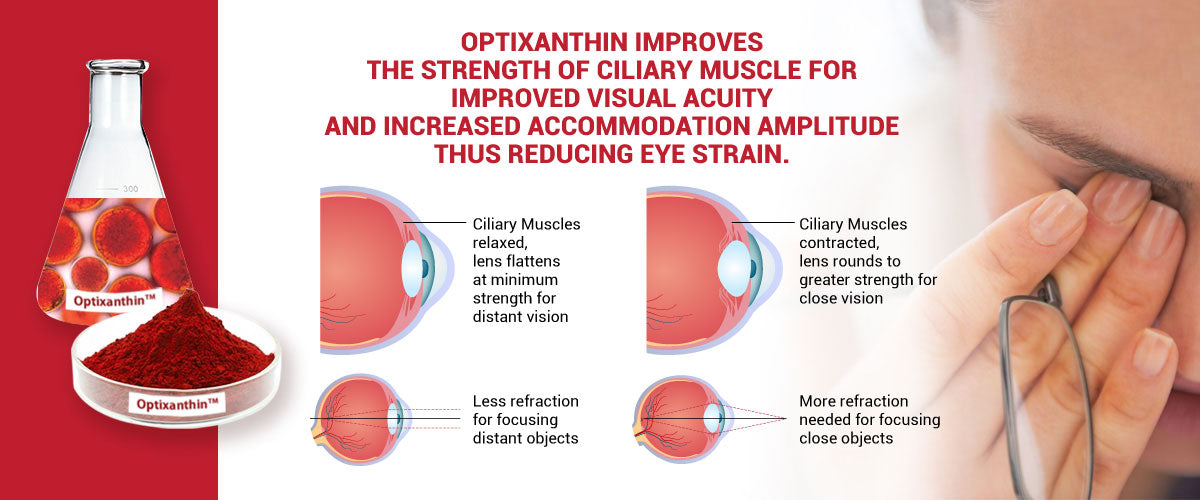Astaxanthin: the potent vision protector
“Eyesight has been described as the most valuable sense organ of our five senses and yet it is the most vulnerable to free radical or reactive oxygen species (ROS) damage” – Dr Robert Corish
Directly hit by light entering our eyes, the outermost layer, lens and cornea are exposed to free radical damage like no other part of the eye. However, this light subsequently penetrates every layer of the eyes, which generates large amount of ROS and give rise to oxidative stress.
A modern enemy to the eye: Blue-ray

Modern lifestyle of desk work, computer and digital devices use, as well as flat-screen television viewing expose us to significant amounts of blue ray daily. News Straits Times reported that Malaysian digital consumers are spending an average of almost 14 hours a day on digital devices with 87% of them on the internet1.
In nature, blue light plays important roles in regulating the circadian rhythm (body’s sleep-wake cycle). However, long-term exposure to blue ray due to extensive use of digital devices contribute to Computer Vision Syndrome (CVS) or Digital Eye Strain. Studies indicate 72 to 76% of Malaysian digital users have features suggestive of CVS1. This can manifest as red, dry or irritated eyes that do not focus well, eye fatigue, headache, neck and shoulder pain.

How does blue light harm our eyes?

Blue light contributes to eye fatigue because it reduces contrast, which makes it harder for the ciliary muscles to focus the eye. As we age, the lens of the eye becomes increasingly rigid, making it even harder for the ciliary muscle to adjust our vision for near focus. “My eyes hurt”… “My eyelids start twitching”… “My neck hurts”… “My shoulders are stiff” are some of the common complaints we come across after prolonged screen time.
Light energy (photons) generate enormous amounts of free radicals. When these particles are in excess, they overwhelm our own innate antioxidant defenses - causing oxidative stress and cellular damage. Growing medical evidences have suggested the high-energy blue light causes oxidative damage to the photoreceptor cells in retina, increasing the risks of macular degeneration and other retinal degenerative conditions.
In this context, astaxanthin offers comprehensive relief for CVS in people who spend long hours on screens. A 2010 double-blind placebo-controlled clinical trial involved computer workers who spent a minimum of 6 hours each day in front of their screens. Each of the participants struggled with eye strain and fatigue. After taking 9 mg of AstaReal® Astaxanthin each day, they felt noticeable relief. Their eyes also functioned better.

Astaxanthin improves ciliary muscles’ endurance and recovery
Ciliary muscles inside the eyes contract to focus on near subjects and relax to focus on distant subjects. Overworked ciliary muscles then affect the ability of the eye to adjust its focus between near and far objects, causing eye fatigue (asthenopia) and blurred vision. Astaxanthin helps the ciliary muscles to recover from hard work and keep them powering, thus reducing eye fatigue and improving focusing ability.

Astaxanthin improves far-to-near refocus time and accommodation amplitude

Astaxanthin improves blood flow to the eyes
Retinal blood flow is the essence of vision as it preserves the eye’s internal balance. Reduced eye blood flow is a feature of the aging process. Astaxanthin helps maintain the retinal blood flow, which improves the nutrition, oxygenation, waste-removal and tissue rejuvenation function of the eye. This consequently combat symptoms linked to CVS and development of eye diseases.
Twenty healthy volunteers took 12 mg of astaxanthin daily for 4 weeks. After 4 weeks, all of the volunteers in treatment group experienced a 16% increase in blood flow to the eye whereas there was no change in the control group4.
Dry eye syndrome (DES)
Astaxanthin reduces inflammation
Dry eye syndrome (DES) is associated with chronic inflammation and oxidative stress. Chronic exposure to free radical further damage the lacrimal glands, tear-secreting tissues, and the conjunctiva epithelial tissues, causing dryness, burning sensation, and sandy-gritty irritation. Astaxanthin helps to mediate inflammation in functional unit of the lacrimal gland, which reduces the damage on eye surface and stabilizes the tear film5.

Clinical benefits of Astaxanthin for focus and eye health
✔ Relieves tired eyes (asthenopia) and helps to focus strained eyes
✔ Helps eyes resist and recover from screen time
✔ Promotes visual acuity
✔ Enhances depth perception
✔ Reduces inflammation of ciliary muscles
Preserve the aging eyes with astaxanthin’s antioxidant activity
Targeting the culprit of aging, the reactive oxygen species (ROS)
The eye is a unique sensory organ which needs more attention to ensure a healthy and productive lifestyle. According to a survey conducted by Johns Hopkins University and published in JAMA Ophthalmology, “losing good vision is the worst ailment”. And when the Ocular Nutrition Society surveyed baby boomers about vision loss, they found that more than half (55%) indicated that they worry about vision loss – almost as much as they worry about heart disease (60%) and cancer (65%).
As we get older, many serious eye issues such as age-related macular degeneration (AMD), cataract and glaucoma become increasingly prevalent. An ounce of prevention for our aging eyes and brains in a combination supplement is what we need: A potent antioxidant and broad spectrum anti-inflammatory that can cross the blood-brain barrier (BBB) and blood-retinal barrier (BRB), bringing antioxidant and anti-inflammatory protection to these vital organs.
Age-related macular degeneration (AMD)
Age-related macular degeneration (AMD) is one of the major causes of vision impairment or blindness in the elderly population6. It occurs due to photoreceptor degeneration in the macula, which is responsible for sharp and high resolution. AMD affects approximately 30 – 35 million worldwide and the numbers are increasing lately7.
Dry type AMD - More common
- Loss of photoreceptor cells and retinal pigment epithelium (RPE) cells
Wet type AMD - Abnormality in a retinal blood vessel (bleed, leak fluid) growth
- Macular damage, thus results in blindness

Oxidative stress and inflammation play a role in contributing to the onset of AMD. Photoreceptors of the retina are highly exposed to UV and blue light, which triggers oxidative stress and results in drusen (yellowish and white deposits) formation. Hence, supplementation with antioxidants and anti-inflammatory agents considerably lower this incidence and revert the late onset AMD to early stage AMD.
Carotenoids seem to play an important role in protecting tissues against UV-light mediated photo-oxidation and are often found in tissues directly exposed to sunlight. Among the many carotenoids available in our diet, the eye selectively accumulates astaxanthin, lutein and zeaxanthin to protect it, and what is remarkable is that astaxanthin protects the whole retina from ROS8.
Additionally, research has shown that the abnormal formation of new blood vessels in the eye was suppressed in wet AMD by astaxanthin supplementation, owing to astaxanthin’s strong antioxidant capacity and anti-inflammatory property9. Patients with AMD also revealed significant improvements in retinal electrical outpours following supplementation with astaxanthin and other carotenoids10.
Presbyopia
Presbyopia (long-sightedness) is the most common symptom of aging eyes, appearing around the age of 40. It is caused by prolonged oxidation of the lens which reduces lens flexibility, making it harder to focus on nearby objects. Most people around this age group started noticing that text appears blurry when viewed up close. This affects the ability to read books or view smartphones.
When we are young, the lens in our eye is flexible and elastic, and can easily change its shape to focus on close and distant objects. The tiny ciliary muscles surrounding the lens contract or relax to adjust the thickness of the lens. With age, oxidative damage to the lens makes the lens stiffer and less flexible. At the same time, ciliary muscles weaken with age. As a result, our lens can no longer change shape to focus on close images, and these images appear out of focus. More recently however, people in their 20s and 30s are reporting smartphone-induced premature presbyopia.
In 2009, Kajita Eye Clinic investigated the effect of astaxanthin in 22 elderly participants with presbyopia. After supplementing with 6 mg/day AstaReal® astaxanthin for 4 weeks, participants experienced a subjective improvement in their presbyopia symptoms, and found their vision to be less blurry when viewing objects up close11.

Cataract


A healthy lens allows for all parts of the retina to receive image versus a cloudy lens scatters light, causing a hazy image and out of focus. (Source: National Eye Institute)
Cataract is another common age-related (degenerative) eye disease in which eye lens gradually become opaque (impaired protein fibers leads to the crystalline lens), thus contributes to blindness than any other eye diseases12. Cataract profoundly affects women than men. It has been identified that aging, smoking, hypertension, diabetes mellitus, malnutrition and UV/sunlight are the major risk factors for the development of cataract13. However, oxidative stress is the main culprit that alters the protein fibres and subsequently triggers the onset of cataract. From this assumption, the strong antioxidative power of astaxanthin could be used to prevent cataract formation.
The beneficial activity of astaxanthin has been recently investigated in the setting of an experimental mouse model of cataract due to hyperglycemia and long-time steroid use. Astaxanthin administration efficiently prevented lens opacification and significantly recovered glutathione levels, suggesting antioxidant activity as the main mechanism involved in cataract prevention14.
In Hashimoto et al. 2007, 37 participants supplementing with 6mg/day AstaReal® astaxanthin were examined for flare intensity levels caused by accumulation of proteins in the aqueous humor post-surgery. The AstaReal® group exhibited significantly lower flare intensity 3 days after surgery compared to the control group, suggesting reduced post-surgery inflammation15.
Glaucoma


Normal vision versus glaucoma vision. (Source: National Eye Institute)
Glaucoma is one of the leading causes of visual impairment and severe irreversible blindness in the world. It is estimated the number of people with glaucoma worldwide will increase to 111.8 million in 2040. Glaucoma is caused by the build-up of fluid in the eye that puts pressure on the optic nerve, retina and lens. This intraocular pressure (IOP) can permanently damage the eye if left untreated.
Accumulation of waste related to aging, high blood pressure, prescription drugs, eye injury or other eye-related illnesses contribute to glaucoma, but oxidative stress can readily be built into the picture of disease initiation and progression, as increased ROS production can damage the previously healthy optic nerve. Studies show that reducing intraocular pressure significantly delays glaucoma progression by improving optic disc damage and visual field loss.
The neuroprotective effect of astaxanthin has gained interest in the prevention and treatment against neurodegenerative disorders including Parkinson’s and Alzheimer’s disease. This has sparked the possibility of astaxanthin to be adopted in the management of glaucoma, due to its antioxidative, anti-inflammatory and anti-apoptotic properties17.
Suppressive effects of astaxanthin on glaucomatous retinal injury was conducted on mouse models. Samples were randomly divided into two groups which received olive oil or 5 mg/kg/day astaxanthin for a period of eight weeks. When compared to controls, elevated IOP returned to baseline levels in the group treated with astaxanthin. In addition, the astaxanthin treatment group also showed a significant reduction of apoptotic cells percentage18.
Diabetic retinopathy
Normal vision versus diabetic retinopathy vision. (Source: National Eye Institute)
Diabetic retinopathy is the most serious sight-threatening complication of diabetes19. The glucose overload that occurs in diabetes increases the production of ROS and depletes cellular antioxidant defense capacities, resulting in oxidative stress. Chronic oxidative stress is considered one of the primary causes of diabetic retinopathy. The retina has a high content of unsaturated fatty acids and high oxygen uptake, which increases lipid oxidation and ROS production, which make the retina more vulnerable than any other tissue to oxidative stress damage20.
Inflammation may also play a key role in the development and progression of diabetic retinopathy21. ROS strongly stimulates the production of inflammation markers in the body, which enforces the vicious cycle of diabetic retinopathy. Therefore, antioxidants like astaxanthin can help to reduce the damage of oxidative stress in the retina, abate the inflammation, and arrest the progression of diabetic retinopathy.
“Astaxanthin, a nutrient like no other, offers a comprehensive support for the eye”
Clinical benefits of Astaxanthin for aging eyes
✔ Promotes good circulation and nourishment of eyes due to the ability to cross
✔ blood-retinal barrier (BRB)
✔ Reduces inflammation of ciliary muscles
✔ Alleviate oxidative stress in eyes
✔ Regulates intraocular pressure
References:
- Dr Prabal Barghava, consultant ophthalmologist at Taylor’s Clinical School. Permanent eye damage danger. News Straits Times, October 10 2019. https://www.nst.com.my/opinion/columnists/2019/10/528466/permanent-eye-damage-danger
- Nagaki Y et al., Efects of astaxanthin on accommodation, critical ficker fusions, and pattern visual evoked potential in visual display terminal workers. J Trad Med. 2002;19:170-73.
- Nakamura A et al., Changes in Visual Function Following Peroral Astaxanthin. Jpn J Clin Opthalmol. 2004;58:1051-54.
- Nitta T et al., Efects of astaxanthin on accommodation and asthenopia – Dose fnding study in healthy volunteers. J Clin Therap Med. 2005;21(5):534-56.
- Saito M et al. Astaxanthin increases choroidal blood flow velocity. Graefes Arch Clin Exp Ophthalmol (2012) 250: 239. https://doi.org/10.1007/s00417-011-1843-1.
- Huang, et al. (2016). “A randomized, double-blind, placebo-controlled study of oral antioxidants supplement therapy in patients with dry eye syndrome.” Journal of Clinical Ophthalmology.10:813-820.
- Vujosevic, S., Pucci, P., Casciano, M., Longhin, E., Convento, E., Bini, S., Midena, E., 2017. Long-term longitudinal modifications in mesopic microperimetry in early and intermediate age-related macular degeneration. Graefe’s Arch. Clin. Exp. Ophthalmol. 255 (2), 301–309.
- Kawasaki, R., Yasuda, M., Song, S.J., Chen, S.J., Jonas, J.B., Wang, J.J., Mitchell, P., Wong, T.Y., 2010. The prevalence of age-related macular degeneration in Asians: a systematic review and meta-analysis. Ophthalmol 117 (5), 921–927.
- Nakajima Y et.al. (2008) J Pharm Pharmacol. Oct;60(10):1365-74
- Izumi-Nagai K et.al. (2008). Invest Ophthalmol Vis Sci. Apr;49(4):1679-85
- Ophthalmology 2008 Feb;115(2):324-333.e2.
- Kajita M et al., The effects of a dietary supplement containing astaxanthin on the accommodation function of the eye in middle-aged and older people. Medical Consultation & New Remedies. 2009;46:89-93.
- Gupta, S.K., Trivedi, D., Srivastava, S., Joshi, S., Halder, N., Verma, S.D., 2003. Lycopene attenuates oxidative stress induced experimental cataract development: an in vitro and in vivo study. Nutr 19 (9), 794–799.
- Roberts, J.E., 2011. Ultraviolet radiation as a risk factor for cataract and macular degeneration. Eye Contact Lens 37 (4), 246–249.
- Ishikawa, S.; Hashizume, K.; Nishigori, H.; Tezuka, Y.; Sanbe, A.; Kurosaka, D. E_ect of astaxanthin on cataract formation induced by glucocorticoids in the chick embryo. Curr. Eye Res. 2015, 40, 535–540.
- Hashimoto H. et al. 2009. Atarashii Ganka (Journal of the Eye), 26 (2):229-234.
- Tham YC et al. 2014. A Systematic Review and Meta-Analysis: Global Prevalence of Glaucoma and Projections of Glaucoma Burden through 2040. American Academy of Opthalmology.
- Moreno MC, Campanelli J, Sande P, et al. Retinal oxidative stress induced by high intraocular pressure. Free Radic Biol Med 2004;37:803–12.
- Cort, A.; Ozturk, N.; Akpinar, D.; Unal, M.; Yucel, G.; Ciftcioglu, A.; Yargicoglu, P.; Aslan, M. Suppressive effect of astaxanthin on retinal injury induced by elevated intraocular pressure. Regul. Toxicol. Pharmacol. 2010, 58, 121–130.
- Klein BE. Overview of epidemiologic studies of diabetic retinopathy. Ophthalmic epidemiology. 2007;14(4):179–83.
- Anderson RE, Rapp LM, Wiegand RD. Lipid peroxidation and retinal degeneration. Curr Eye Res. 1984;3(1):223–7.
- Joussen AM, Murata T, Tsujikawa A, Kirchhof B, Bursell SE, Adamis AP. Leukocyte-mediated endothelial cell injury and death in the diabetic retina. Am J Pathol. 2001;158(1):147–52.


